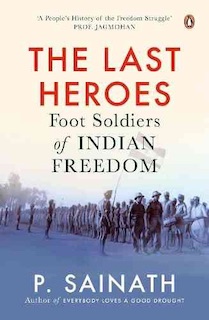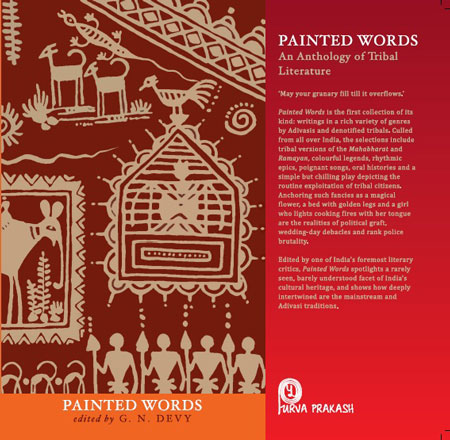Photo: S. Subramanium – The Hindu
“AV Thakkar, a Gandhian nationalist and the one-time head of of the Harijan Sevak Sangh […] advocated for bringing tribes into the Hindu fold.” – Richard Kamei (doctoral candidate at the Tata Institute of Social Sciences in Mumbai) in “Uncivilising the Mind: How anthropology shaped the discourse on tribes in India” (Caravan Magazine, 1 March 2020) | Learn more >>
A 1941 lecture by Thakkar in Pune highlighted negative stereotypes [and the] cultural racism in such stereotypes forms the backdrop to the continuing discrimination and humiliation of Adivasis. | Learn more >>
[…] With a stone sculpture of Mahatma Gandhi leading a march in addition to the tribal motifs and figures adorning it, how come such a visible and accessible structure has failed to draw any visitors all these years? On any given day, Bharatiya Adimjati Sevak Sangrahalaya, which has the most beautiful dioramas illustrating tribal life, in the Capital, tragically doesn’t receive more than 10 people.
The museum is part of Bharatiya Adimjati Sevak Sangh (BASS), a non-governmental organisation working for the welfare of tribals. The organisation was established before Independence by Amritlal Vithaldas Thakkar (came to be known as Thakkar Bappa), a close associate of Mahatma Gandhi, who became concerned with the plight of tribals in the country. And that’s how was born the Sangh, which had Rajendra Prasad as its first President. […]
School students, in particular those, who take interest in geography, would love the depiction of these known and unknown tribes like Bondos of Orissa, Yenadi of Andhra Pradesh, Baigas of Madhya Pradesh, Jounsari of Uttar Pradesh, Daflas of Arunachal Pradesh, Todas of Tamil Nadu, Ongis of the Andamans, Zeiliang Rong of Nagaland, Bhils of Gujarat, etc. The dioramas have been made by Fakir Chand Paruda of Odisha.
In the corridor are displayed tribal costumes like colourful, hand knit cotton saris, ghaghra-choli and dupatta, wraparounds called dokhna (worn by Bodos of Assam), grass loincloth worn by the Ongi tribe of Andamans and Nicobar Islands. The smaller rooms are also a treasure trove housing musical instruments, ornaments, utensils, weapons and indigenous herbs and medicines. […]
Read the full article by SHAILAJA TRIPATHI in The Hindu, New Delhi, April 14, 2014 >>
Hidden on the side of a busy road on Central Delhi’s Ambedkar Marg, adjacent to Jhandewalan Metro Station, is this treatise on tribes in India or the Delhi Tribal Museum. You can look for the life-size images including one of Gandhi Ji, on top of a building to identify this building. | Read the full article and view a series of photographs >>
The building is officially called Thakkar Baba Smarak Sadan in memory of the person who started this movement under the guidance of Mahatma Gandhi.
The manager of the museum will happily describe the place to you along with its history and the activities of the NGO. There are not many visitors to this place. But I am sure it can do better with a bit of publicity or campaigns. […]
Tribal or Adivasi is a term used for describing the aboriginals of India. Living in small pockets across the country. They now form such a small minority that they almost need to be protected. Most Adivasis live in remote and usually geographically isolated areas. Follow their own distinct culture, law, and ethics. And maintain a minimal contact with the outside world. Their world is self-contained in them. […]
I enjoyed this quite visit the museum. Since there were no other visitors, we had the whole museum to us for a couple of hours that we were there. I wish there are more visitors to keep this place alive.
Source: “Delhi Tribal Museum – Tribal Know How Under One Roof” by Anuradha Goyal https://www.inditales.com/tribal-museum-delhi/
Visited: 5 May 2018
Bharti Adam Jati Sevak Sangh
Bharatiya Adimjati Sevak Sangh
Thakkar Bappa Smarak Sadan
Dr.Ambedkar Marg
New Delhi- 110055
T: 011-23625492
Visit | http://www.bajss.org/contact.php
Timings: 11 a.m to 5 p.m.
Public transport:
Adjacent to Jhandewalan Metro
Station Gate No. 4,
Dr. Ambedkar Marg (Link Road)
Telephone
+91 11 23625492
+91 11 23532003
Email
bajss49@rediffmail.com
Bhartiya Adim Jati Sevak Sangh (BAJSS), the name, itself, illuminates the sublime motive, i.e., “All-Inclusive & All-Round uplift of The Tribal Communities of India”. Confined to the motive, Late Sh. Thakkar Bapa, an eminent social worker and a close-aid of Mahatma Gandhi, had established the esteemed institution in 1949. Since its inception, serving as a Mother Institution, it had spun out the stronger network of such like-minded institutions and branches across the entire country.
Source: Bharti Adam Jati Sevak Sangh
Address: http://www.bajss.org/
Date Visited: Tue Apr 11 2017 16:13:17 GMT+0200 (CEST)
Located in New Delhi, Bharatiya Adimjati Sevak Sangh houses an extensive collection of tribal artifacts and small and life size dioramas, which depict life style and setting of the tribal people.
The exhibits include musical instruments, weapons, medicinal plants, agricultural implements, hunting implements, ornaments, handicrafts and dioramas. Library facilities are available.
Source: Tribal Museum – Bharatiya Adimjati Sevak Sangh in New Delhi India
Address: http://www.india9.com/i9show/Tribal-Museum—Bharatiya-Adimjati-Sevak-Sangh-26978.htm
Date Visited: Tue Apr 11 2017 15:48:53 GMT+0200 (CEST)
Activities
Since its inception in 1948, Bhartiya Adim Jati Sevak Sangh has committed to the all-round and all-inclusive development of the tribes both nomadic and denotified, i.e. Vimukta, tribal communities residing in the deserted faraway vicinities and isolated hamlets. The object could be attained by promoting their socio-cultural and economic progress. Further, BAJSS is committed to safeguard their constitutional rights with a view to enable them to take their legitimate share in the national life of the country as equal citizens. To attain the sublime objective, with the dedicated network of it branches and affiliated institutions, BAJSS is coordinating the giant multi-focal and multi-dimensional tasks on Pan-India level. So far, the institution is fulfilling the crucial role as a spearheading implementing agency for various welfare programmes launched by Ministry of Tribal Welfare and Ministry of Woman & Child Development, Government of India. BAJSS along with its confederation of affiliated and recognized institutions has offered a unique kind of contribution in the vital segments like Child care, Education, Eradication of Social Injustice and Women Empowerment. BAJSS has coordinated various activities as follows.
Source: Bharti Adam Jati Sevak Sangh : Activities
Address: http://www.bajss.org/activities.php
Date Visited: Tue Apr 11 2017 16:09:52 GMT+0200 (CEST)

Adivasi | Books | Publishers >>
History | Success stories >>
History
Confined to the gracious motive, Late Sh. Amritlal Vithaldas Thakkar, popularly known as ‘Thakkar Bapa’, an eminent social worker and a close-aid of Mahatma Gandhi, had established the esteemed institution on October 24th, 1948 in Delhi. Dr. Rajendra Prasad, the First President of Independent India was designated as the proud Founder-President of BAJSS. The eminent leaders-Social Workers like Sh. U.N. Dhebar, Sh. Moraraji R. Desai, Dr. Smt. Phulrenu Guha and Sh. J. H. Chinchalkar had offered their valuable services to the supreme cause, i.e., The Cohesive Uplift of the Tribes of India.
Source: Bharti Adam Jati Sevak Sangh : About Us
Address: http://www.bajss.org/about.php
Date Visited: Tue Apr 11 2017 16:12:10 GMT+0200 (CEST)
Amritlal Vithaldas Thakkar, popularly known as Thakkar Bapa (29 November 1869 – 20 January 1951) was born at Bhavnagar, Gujarat. “Bapa” in Gujarati means Father in English. He was an Indian social worker who worked for upliftment of tribal people in Gujarat state in India. He became a member of the Servants of India Society founded by Gopal Krishna Gokhale in 1914.[1] In 1922, he founded the Bhil Seva Mandal. Later, he became the general secretary of the Harijan Sevak Sangh founded by Mahatma Gandhi in 1932 .[2] The Bharatiya Adimjati Sevak Sangh was founded on the 24 October 1948 on his initiative.[3] When Indian constitution was in process, Thakkarbapa visited remotest and most difficult parts of India and conducted probe into the situation of tribal and Harijan people. He added valuable inputs in the process of constitution. Mahatma Gandhi would call him ‘Bapa’.
Thakkarbapa visited forests in Assam, rural Bengal, drought affected areas of Orissa, Bhil belts in Gujarat and Harijan areas of Saurashtra, Mahar areas of Maharashtra, untouchables in Madras, hilly areas of Chhota Nagpur, desert of Tharparkar, foothills of Himalaya, coastal areas of Travankor with his mission of upliftment of tribal and harijans. […]
The Madhya Pradesh state government has instituted an award named in his honor for dedicated services to poor, victimised and totally backward tribal community.Maharashtra government has set the scheme to improve aadivasi villages and colonies named Thakkar Bappa aadivasi vasti sudharana in the year 2007.
Source: Thakkar Bapa – Wikipedia
Address: https://en.wikipedia.org/wiki/Thakkar_Bapa
Date Visited: Tue Apr 11 2017 15:53:57 GMT+0200 (CEST)
Tips for using interactive maps
Toggle to normal view (from reader view) should the interactive map not be displayed by your tablet, smartphone or pc browser
For details and hyperlinks click on the rectangular button (left on the map’s header)
Scroll and click on one of the markers for information of special interest
Explore India’s tribal cultural heritage with the help of another interactive map >>
See also
Adverse inclusion | Casteism | Rural poverty
Childhood | Tribal Children’s Right to Education in India
Demographic Status of Scheduled Tribe Population of India (Census figures 2011)
Fact checking | Figures, census and other statistics
Human Rights Commission (posts) | www.nhrc.nic.in (Government of India)
Search tips | Names of tribal communities, regions and states of India
“What is the Forest Rights Act about?” – Campaign for Survival and Dignity
“Who are Scheduled Tribes?” – Government of India (National Commission for Scheduled Tribes, NCST)

Tribal Literature by G.N. Devy >>
Free eBooks & Magazine: Adivasi literature and languages >>
“India, a union of states, is a Sovereign, Secular, Democratic Republic with a Parliamentary system of Government. The President is the constitutional head of Executive of the Union. In the states, the Governor, as the representative of the President, is the head of Executive. The system of government in states closely resembles that of the Union. There are 28 states and 8 Union territories in the country. Union Territories are administered by the President through an Administrator appointed by him/her. From the largest to the smallest, each State/UT of India has a unique demography, history and culture, dress, festivals, language etc. This section introduces you to the various States/UTs in the Country and urges you to explore their magnificent uniqueness…” – KnowIndia (Government), States and Union Territories (Visited: 2 September 2023)
Learn more about India’s 28 States and 8 Union Territories – From Andhra Pradesh to West Bengal | Nutrition >>